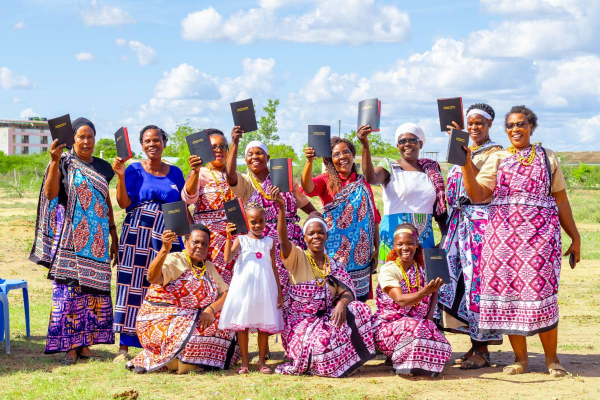Every Sign Matters
Deaf in Japan are meeting God through Scripture.

One of the first things that happened when I met the Japanese Sign Language (JSL) translation team was that they gave me my own sign name.
I didn’t realize, until later on, that this was important. They saw me as part of the team. The sign that I received had to do with my curly hair; one of the staff members showed me by holding her hands up on either side of her head, slowly making a fluffing motion from top to bottom, as if outlining the hair.
When I tried it, the team smiled and clapped to indicate that I had gotten it right. (Later on, one of the JSL team members would tell me that my sign name is also the sign for a popular coffee chain. I felt even more elated with my sign name after that.) To be honest, before I met the Japanese Sign Language team, I didn’t know all that much about the complex world of sign language.
There are more than 380 known sign languages in the world, and only American Sign Language has the full Bible. According to our partners, Deaf Bible Society, there are now more than 75 active sign language projects taking place around the world!
The Deaf are often considered to be the largest unreached people group for that reason. And because they’re a minority, the Deaf are often at a disadvantage when it comes to operating within a hearing culture. Some of the JSL team members have experienced hardships because of being Deaf and many expressed the same sentiments: they were taught, growing up, that they needed to speak and not sign. Even in school, JSL team members noted that they were instructed to learn written Japanese. Imagine being taught a language in school that would make everyday communication difficult. Now imagine trying to understand a Bible in that language.
Sign Language Translation
You can help bring the hope of Scripture to Deaf people around the world by praying for the Japanese Sign Language project and other translation projects like it.
Learn and Pray
That’s why, in 1992, leaders of Deaf ministries in Japan gathered together to discuss the need for a Japanese Sign Language Bible. And in 1993, ViBi (which stands for “Visual Bible and Video Bible”) was born; this is the group I met with who are working to translate Scripture into Japanese Sign Language.
Sign language communication involves a person’s whole body: their hands, their eyes, their facial expressions, their body movements, and even the space in front of and around them. A word can take on an entirely new or unintentional meaning depending on the facial expressions — down to the movement of the eyebrows — used to accompany a sign. For the Deaf to easily understand and engage with the Bible, it must be conveyed in video format.
EVERY SIGN MATTERS
When I met the JSL team, they were working on translating the book of Daniel. They had already published Daniel 1‑6 and it was available on an app for the Japanese Deaf.
They began outlining Daniel 7‑12 on a grey and gloomy morning, but we were all thankful that the intermittent rain outside was cooling the city down. The team of translators and exegetical consultants gathered around two folding tables with their laptops, pens, Japanese Bibles and Post-It notes in front of them. They were huddled upstairs in ViBi’s office which consisted of a small house with two rooms upstairs and one downstairs. Because of the lack of space, the administrative staff members work in a building less than a quarter of a mile down the road above a milk delivery place.

Uiko Yano, the ViBi project leader, led the group as they went back and forth among themselves trying to determine how to explain and summarize the big picture of Daniel 7‑12.
Daniel chapters 1‑6 are pretty concrete and contain the stories most of us have known since we were young: Daniel and the lion’s den, the statue and the fiery furnace. Nearly everyone, Christian or not, knows those stories. But Daniel 7‑12 features so many visions with complicated details, beasts and characters. Trying to determine exactly how to portray even one verse can be difficult.
Because sign languages are dependent on facial expressions, hand movements and body language, no detail is wasted. Every movement matters. Every sign matters.

The workgroup broke for lunch and we sat around the table together downstairs in the ViBi conference room, dragging a variety of chairs around the office’s table. Some of the translation team members brought their lunches, while some walked nearby to a grocery store to purchase salad, chicken and desserts. When the JSL team is around the lunch table, they don’t mention work until they have to. They laugh, ask about life and try to swipe each others’ desserts.
After lunch, they began to draft the first few verses of Daniel 7. It took hours.
I peeked into the room a few times during the afternoon and asked my translator friend, Donna, from Deaf Bible Society, what was happening. She kindly informed me that the team was debating the meaning of Daniel 7:6, which says: “Then the third of these strange beasts appeared, and it looked like a leopard. It had four bird’s wings on its back, and it had four heads. Great authority was given to this beast” (NLT; emphasis mine).

When I asked about why the team was debating the meaning of this particular verse, Donna elaborated: In a hearing culture, she explained, we know the Bible is open to interpretation. So when a hearing person reads a verse like Daniel 7:6, we can conjure an image in our heads of whatever we’d like. For example: What do you imagine the four wings look like? You can picture big wings, small wings, wings on the beast’s back or wings on its side. But for a Deaf person to understand a passage, they need to see it visually. And in Japanese Sign Language, there isn’t just one way to say “wings” like there is in the English written language. There are specific, different signs to say “wings on the back” or “wings on the side” or “big wings.” Context is everything.
It might seem odd to us — a 15‑ or 20‑minute debate between team members over the best sign to use for “wings” in Daniel 7:6. But being clear and accurate are two things that the JSL team members value.
Whether it’s Daniel 7:6 or John 3:16, every verse matters.
UNBURDENED FROM STRESS
When people are able to understand Scripture in a language and format that reaches their hearts, lives are transformed. But there are practical, subtle transformations that happen too. Until I watched Tadashi Nagasawa, a member of the Yamagata Deaf Christ Church, sign about his experience, I never considered that reading might be stressful for a Deaf person:
“A few years ago I had a stomach ache and was hospitalized. The doctor explained to me that it was due to stress. I wasn’t sure where I got the stress. … I think I didn’t preach for a year or something. Then later I was asked … to preach. … It’d been a long time since I had preached, but I accepted it and opened my Bible to prepare. … So I opened my Bible, started reading and studying it. Then I felt the pain in my stomach. I thought to myself: ‘This is probably the same stress that the doctor mentioned to me when I was in the hospital.’

“After that, I was asked again to preach, but this time I said no because of the pain in my stomach. But Pastor Matsumoto kindly offered to help me and explained the content of the Bible in JSL for my preparation for preaching. And when he did that, I did not feel any pain.”
Sign languages and spoken languages have completely different syntaxes. The way that we order words in spoken languages differs from the way that words and phrases are ordered in sign languages. And spoken languages are phonetic, relying on connections between text and sound. As Uiko explained: “For Deaf people … they need something that’s visual. … As hearing people read, there’s a connection between text and sound. For us as Deaf people, we cannot hear and we’re never going to have that connection between the sound and the text. … Visually seeing the hand movement in sign language is very important for us.”
THE LOVE OF GOD IN SIGN LANGUAGE
The Deaf need Scripture in a format that makes sense to them: video. And they deserve to understand God’s love for them in their language.

Toshie Otsubo, the administrative assistant for the ViBi team, is an older woman who acts as the team’s “grandmother”; she arranges everyone’s shoes into neat rows at the front door of the ViBi house. She cleans dishes and takes out the garbage. She takes care of the team.
Toshie has spent most of her life reading the Japanese Bible. “But when I started working for ViBi, it really changed my perspective,” she signed. “What I really didn't get in [written] Japanese, I understood so easily in the JSL Bible. For example in John 3:16, it says that God so loved the world [that] he gave us eternal life. When I read this Scripture in Japanese, I thought that God gave eternal life to someone. But when I watched [it] in JSL … I truly understood that it includes everyone.”
She concluded: “I was finally able to grasp the deeper context … [and] I'm so thankful for that. It is my hope and prayer that more and more Deaf people will be reached through JSL Bible with more understanding of the Word of God.”
Toshie cried after she shared her story. I did too.
There’s nothing more powerful than understanding God’s love in your own language.
Sign Language Translation
You can help bring the hope of Scripture to Deaf people around the world by praying for the Japanese Sign Language project and other translation projects like it.
Learn and Pray



_1764969725_600x400.jpg)



